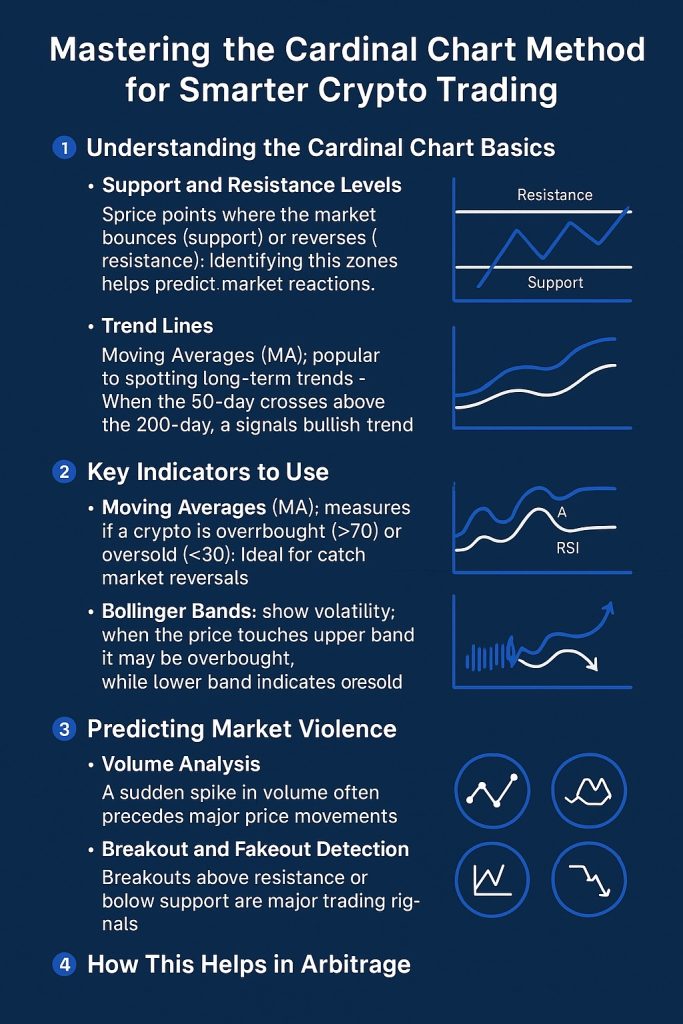At now there are crypto arbitrage teams and signal groups that provide daily signals for a fee or a share of your profits. However, you can learn how to read the cardinal chart and predict the market violence to get profits.
Platforms like ArbitrageScanner, Pionex, and Bitsgap offer automated tools and signal services for arbitrage trading. However, before joining any paid group, it’s important to understand:
- Transparency and Track Record:
- Check if the team has verified trading history.
- Look for user reviews and third-party verifications.
- Risk Management:
- Arbitrage might seem risk-free, but factors like network fees, slippage, and withdrawal limits can impact profits.
But there’s an even smarter way to profit in crypto trading:
Understanding the Cardinal Chart Method and learning to predict market volatility can help you take advantage of market swings even without paid signals. By mastering these strategies, you can:
- Spot profitable arbitrage opportunities yourself.
- Time your trades better for maximum profit.
- Reduce dependency on external signals and grow your own expertise.
Mastering the Cardinal Chart Method for Smarter Crypto Trading

The Cardinal Chart Method is a strategic way to predict market volatility and spot entry/exit points in crypto trading. It focuses on analyzing price movements, volume trends, and support/resistance levels to anticipate big market swings. Here’s a breakdown:
 Understanding the Cardinal Chart Basics:
Understanding the Cardinal Chart Basics:
- Support and Resistance Levels:
- These are price points where the market historically bounces (support) or reverses (resistance).
- Identifying these zones helps predict market reactions.
- Trend Lines:
- Drawing lines along the highs and lows shows the current market trend.
- An upward trend suggests bullish momentum, while a downward trend signals bearish conditions.
 Key Indicators to Use:
Key Indicators to Use:
- Moving Averages (MA):
- 50-day and 200-day MA are popular to spot long-term trends.
- When the 50-day crosses above the 200-day, it signals a bullish trend (“Golden Cross”).
- Relative Strength Index (RSI):
- Measures if a crypto is overbought (>70) or oversold (<30).
- Ideal for catching market reversals.
- Bollinger Bands:
- These show volatility.
- When the price touches the upper band, it may be overbought; the lower band indicates oversold.
 Predicting Market Violence:
Predicting Market Violence:
- Volume Analysis:
- A sudden spike in volume often precedes major price movements.
- Watch for high volume near support or resistance—this usually signals a breakout.
- Breakout and Fakeout Detection:
- Breakouts above resistance or below support are major trading signals.
- Be cautious of fakeouts where the price briefly crosses the line and reverses.
 How This Helps in Arbitrage:
How This Helps in Arbitrage:
By understanding the Cardinal Chart Method, you can predict:
- Price Swings: Enter and exit trades with precision.
- Volatile Moments: Know when the market is heating up for arbitrage.
- Market Corrections: Avoid risky positions during downturns.




 Understanding the Cardinal Chart Basics:
Understanding the Cardinal Chart Basics: Key Indicators to Use:
Key Indicators to Use: Predicting Market Violence:
Predicting Market Violence: How This Helps in Arbitrage:
How This Helps in Arbitrage:



